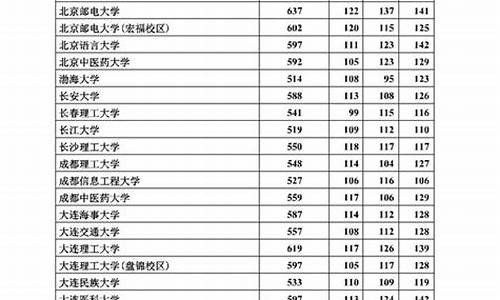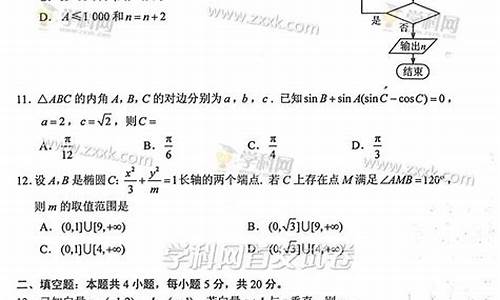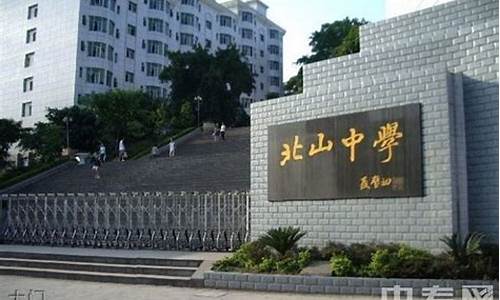您现在的位置是: 首页 > 教育趋势 教育趋势
河北2017高考科目,2017河北省高考
tamoadmin 2024-06-19 人已围观
简介1.高考政策2.2017年高考全国各省市使用什么考卷3.新高考改革方案20174.2017年使用全国卷1的省份有哪些5.2017高考哪些省份使用全国卷I 2017高考哪些省份使用全国卷16.河北英语高考题2017年根据报道,近日,教育部办公厅发布的《关于2017年普通高等学校招生全国统一考试全国统考科目时间安排的通知》,2017年高考时间为6月7日、8日,各省(区、市)考试科目名称与全国统考科目名
1.高考政策
2.2017年高考全国各省市使用什么考卷
3.新高考改革方案2017
4.2017年使用全国卷1的省份有哪些
5.2017高考哪些省份使用全国卷I 2017高考哪些省份使用全国卷1
6.河北英语高考题2017年

根据报道,近日,教育部办公厅发布的《关于2017年普通高等学校招生全国统一考试全国统考科目时间安排的通知》,2017年高考时间为6月7日、8日,各省(区、市)考试科目名称与全国统考科目名称相同的必须与全国统考时间安排一致。
《通知》指出,根据《教育部关于做好2017年普通高校招生工作的通知》有关要求,2017年普通高等学校招生全国统一考试全国统考科目的考试时间安排为:
6月7日 9:00 至11:30 语文;15:00至17:00 数学。
6月8日 9:00 至11:30 文科综合/理科综合;15:00至17:00 外语,有外语听力测试内容的应安排在外语笔试考试开始前进行。
《通知》表示,各省(区、市)考试科目名称与全国统考科目名称相同的必须与全国统考时间安排一致。具体考试科目时间安排应通过国家教育考试考务管理平台报教育部考试中心备案。
高考政策
2017年河北省高考分数线一本分数线文科517分,理科485分,二本分数线文科395分,理科326分。
2017年6月22日,河北省招生委员会召开全体会议,研究划定了今年河北省普通高校招生各批各类录取控制分数线,确定了录取相关工作。其中,文史类本科一批为517分,理工类本科一批为485分;二本分数线文科395分,理科326分。
2023年河北高考考试科目
河北高考包括统一高考和普通高中学业水平选择性考试。统一高考科目为语文、数学、外语3门,其中,外语科目分为英语、俄语、日语、德语、法语、西班牙语等6个语种,考生任选其中1个语种参加考试。统一高考科目试题由教育部统一命制。
选择性考试科目为思想政治、历史、地理、物理、化学、生物6门,考生须从历史、物理2门首选科目中选择1门,再从思想政治、地理、化学、生物4门再选科目中选择2门参加考试。选择性考试科目试题由河北省自主命制。
2023年河北高考时间及科目安排
1、6月7日9:00至11:30为语文,15:00至17:00为数学。
2、6月8日9:00至10:15为物理/历史,15:00至17:00为外语。
3、6月9日8:30至9:45为化学,11:00至12:15为地理,14:30至15:45为政治,17:00至18:15为生物。
2017年高考全国各省市使用什么考卷
2021年新高考政策解读
“3+3”模式
在高考新方案中,文理不分科已成各地高考改革趋势,高考科目“3+3”也成众多省份未来高考的新模式。
“3+3”模式是指,报考普通本科院校的考生,其高考成绩将由语文、数学、外语3门统一高考成绩和考生选考的3门普通高中学业水平考试等级性考试科目成绩构成。学生不再分文理科,可以自主选择选考科目。就3门选考科目而言,各地多采用“6选3”模式,即从思想政治、历史、地理、物理、化学、生物6个科目中自主选择3科作为考试科目。值得注意的是,浙江采取的是“7选3”模式,除了以上所提到的6科,还多了“技术(含通用技术和信息技术)”这项科目。
在分值设置上,绝大多数省份明确统一高考的语文、数学、外语每科满分150分,学生自选3门科目每门满分100分,总分合计750分。不过,上海、西藏有所不同,明确3门选考科目每门70分,高考成绩总分满分660分,此外,江苏高考科目分值尚未最终确定,但明确比现行的480分要高。海南要求以每个科目原始分转换后的标准分呈现考生成绩,这是目前仅有采用标准分这一计分方法的省份。
与高考科目变化相对应的一项措施是高中学业水平考试,不少省份也公布了改革时间表。比如,北京将从2017年启动高考综合改革,从秋季入学的普通高中起,年级开始实施高中学业水平考试,实行合格性考试和等级性考试,计入高校招生录取总成绩的学业水平考试3个科目成绩以等级呈现,其他科目一般以“合格、不合格”呈现。
力求破除“一考定终身”是新一轮高考改革的重点方向。在已公布高考改革方案的19省份中,绝大多数省份明确,外语科目提供两次考试机会,考生可选择其中较高一次考试成绩计入。
深化外语考试改革上,上海明确要建设外语标准化考试题库和标准化考场,外语考试要为今后其他科目逐步推行标准化考试积累经验。
80%省市改革2020年、2021年执行
北京高考综合改革方案
执行:2020年
从2017年秋季入学的高中一年级开始,取消文理分科。从2020年起,高考统考科目为语文、数学、外语。高考成绩由3门统考成绩和考生选考的3门普通高中学业水平考试等级性考试科目成绩构成。英语一年考两次。
天津高考综合改革方案
执行:2020年
从2017年秋季入学的高中一年级开始,取消文理分科。从2020年起,高考统考科目为语文、数学、外语。高考成绩由3门统考成绩和考生选考的3门普通高中学业水平考试等级性考试科目成绩构成。英语一年两考,取较高的分数计入高考总分。
河北高考综合改革方案
执行:2021年
从2018年秋季入学的高一学生开始,取消文理分科;外语科目提供两次考试机会。2021年起,高考统考科目为语文、数学、外语3科。高考成绩由统考科目和学生选考科目构成。逐步取消高校招生录取批次。
山西高考综合改革方案
执行:2021年
2018年秋季入学的高一学生起,不分文理科。2021年起,高考统考科目为语文、数学、外语3科。高考成绩由统考科目和学生选考科目构成。外语听力“一年两考”,取较高一次成绩计入高考总分
内蒙古高考综合改革方案
执行:2021年
2018年秋季入学的高一学生起,不分文理科。2021年起,高考统考科目为语文、数学、外语3科。高考成绩由统考科目和学生选考科目构成。
黑龙江高考综合改革方案
执行:2021年
2018年秋季入学的高一学生起,不分文理科。外语科目提供两次考试机会。2021年起,高考统考科目为语文、数学、外语3科。高考成绩由统考科目和学生选考科目构成。吉林高考综合改革方案
吉林高考综合改革方案
执行:2021年
2018年秋季入学的高中一年级学生开始,不分文理。外语科目提供两次考试机会。2021年起,高考统考科目为语文、数学、外语3科。高考成绩由统考科目和学生选考科目构成。
辽宁高考综合改革方案
执行:2021年
2018年秋季入学的高中一年级学生开始,不分文理。外语科目提供两次考试机会。2021年起,高考统考科目为语文、数学、外语3科。高考成绩由统考科目和学生选考科目构成。
上海高考综合改革方案
执行:2017年
2017年起,高考统考科目为语文、数学、外语3科,不分文理科。高考成绩由统考科目和学生选考科目构成,满分660分。外语考试一年举行两次,可选其中较好的一次成绩计入高考总分。2016年起,合并本科第一、第二招生批次,并按照学生的高考总分和院校志愿,分学校实行平行志愿投档和录取。仅报考专科高职志愿的学生,只计语文、数学、外语3门统一高考成绩。专科高职依据统一高考成绩进行录取。
山东高考综合改革方案
执行:2020年
2017年秋季高中入学新生开始,不分文理科;2020年开始,夏季高考统一考试科目为语文、数学、外语。外语考试分两次进行。高考总成绩由3门统考科目和学生选考科目构成,总分为750分;实行“专业(类)+学校”志愿填报模式。2020年起,春季高考统一考试总分750分,其中文化素质部分320,专业技能部分430。
江苏高考综合改革方案
执行:2021年
自2021年起(2018年秋季高中入学新生开始),江苏省普通高考统考科目仍为语文、数学、外语3门,保持不变;选考科目由现行的“6选2”调整为“6选3”,并计入高校招生录取总成绩。
安徽高考综合改革方案
执行:2021年
2021年高考录取考生总成绩不分文理科。改进初中学业水平测试的考试形式和方式。增加高校和学生双向选择机会。减少和规范考试加分。高中学业水平考试涵盖所有科目。综合素质评价成为毕业和升学的重要参考。
浙江高考综合改革方案
执行:2017年
考试科目为语数外+3门选考科目,不分文理;除语数,其他科目都有2次考试机会,成绩2年有效;高校提前两年公布选考科目范围,至多3门,考生1门符合就可报考;高考录取不分批次,“专业+学校”平行志愿,按专业平行投档;等级赋分方案:考生各科成绩按等级赋分,以当次高中学考合格成绩为赋分前提,高中学考不合格不赋分。起点赋分40分,满分100分,共分21个等级,每个等级分差为3分。
江西高考综合改革方案
执行:2021年
从2018年秋季入学的高一学生开始将取消文理分科。到2021年高考时将按照“3+3”标准进行。
福建高考综合改革方案
执行:2021年
2021年起,统一高考科目为语文、数学、外语3门,不分文理科;外语科目提供2次考试机会;考生总成绩由统考科目和学生自选3门科目成绩组成。
河南高考综合改革方案
执行:2021年
从2018年秋季入学的高中一年级学生开始,高考总成绩由统一高考的语文、数学、外语3个科目成绩和3个选考科目考试成绩组成。
湖北高考综合改革方案
执行:2021年
2018年高一年级新生开始实施,文理不分科;从2021年起,实行“3+3”模式。高考总成绩=“语数外”全国卷高考成绩+3门“学考”成绩;外语有两次考试机会,可选择其中较好的一次成绩计入高考成绩。
湖南高考综合改革方案
执行:2021年
2018年高一年级新生开始实施,文理不分科;从2021年起,实行“3+3”模式。高考总成绩=“语数外”全国卷高考成绩+3门“学考”成绩;外语有两次考试机会,可选择其中较好的一次成绩计入高考成绩。高考新政落地后,走班将成为常态。
广东高考综合改革方案
执行:2021年
2021年起(2018年秋季高中入学新生开始)高考开始实行高考综合改革方案,高考科目为“3+3”,即语文、数学、外语3门科目和3门高中学业水平考试科目的考试方式。
广西高考综合改革方案
执行:2022年
2019年秋季入学新高一学生起,不分文理科;从2022年起,实行“3+3”模式。高考总成绩=“语数外”全国卷高考成绩+3门“学考”成绩;外语科目(含听力)提供两次考试机会。高校招生录取实行“考生总成绩+综合素质评价”的评价方式。
海南高考综合改革方案
执行:2020年
从2020年起(2017年秋季高中入学新生开始),高考录取总成绩=“语数外”全国卷高考成绩+3门“学考”成绩;录取批次仅设本科批次和专科批次,即原来的一、二、三本将被合并为本科批。本科批次初步拟定考生可以填报20个“院校专业组”志愿。每个“院校专业组”内,考生最多可填报6个专业志愿和是否服从专业调剂志愿。高考时间调整为4天,统考科目(语、数、外)6月7-8日举行;选考科目6月9-10日进行
陕西高考综合改革方案
执行:2022年
2022年起(2019年秋季入学的高一学生开始),高考成绩由全国统一考试的语文、数学、外语3个科目成绩和学生自选的3个科目的等级性考试成绩组成。外语科目提供两次考试机会,选择较好的一次成绩计入总分。
宁夏高考综合改革方案
执行:2022年
统一高考科目调整为语文、数学、外语3个科目,分值不变,不分文理科,选考科目调整为“6选3”。
甘肃高考综合改革方案
执行:2022年
考生总成绩由统一高考的语文、数学、外语3个科目成绩和高中学业水平考试3个科目成绩组成。外语科目提供两次考试机会。
青海高考综合改革方案
执行:2022年
实行“3+3”的考试模式,选考科目“6选3”;外语科目提供两次考试机会;高考招生录取基于“两依据、一参考”;2018年在各批次全面实行平行志愿,并创造条件逐步取消高校招生录取批次。
新疆高考综合改革方案
执行:2022年
暂无。
重庆高考综合改革方案
执行:2021年
2018年入学的高中一年级新生开始,考试不分文理科;2021年开始,高考总成绩为全国统考科目(语文、数学、外语)+高中学业水平考试选考科目的总和;
四川高考综合改革方案
执行:2021年
从2018年秋季新入学的高一年级起,计入高考总成绩的学业水平考试科目实行全省统一命题、统一考试、统一评卷、统一公布成绩;从2021年开始,统一高考考试科目设置为语文、数学、外语3门,不分文理科,外语科目提供两次考试机会,取最好成绩计入总成绩;从2021年开始,高职院校考试招生时间安排在当年春季;取消体育特长生等所有鼓励类加分项目。
贵州高考综合改革方案
执行:2021年
2018年秋季入学的高中一年级学生开始实施,不再分文理科;2021年开始高考成绩由“3+3”构成;录取机制为“两依据一参考”。
云南高考综合改革方案
执行:2022年
从2019年秋季入学的高中一年级学生开始,实施统一高考改革。2022年云南高考不分文理科,外语科目提供两次考试机会,考试科目由现行的3+文综、理综,改为“3+3”。
西藏高考综合改革方案
执行:2021年
从2018年秋季入学的高一年级学生开始,全面启动普通高等学校考试招生综合改革,2021年起,调整统一高考科目,高考将不再分文理科。
新高考改革方案2017
2017年高考全国各省市使用的考卷:
1、全国Ⅰ卷地区:河南、河北、山西、江西、湖北、湖南、广东、安徽、福建
2、全国Ⅱ卷地区:甘肃、青海、内蒙古、黑龙江、吉林、辽宁、宁夏、新疆、西藏、陕西、重庆
3、全国Ⅲ卷地区:云南、广西、贵州、四川(四川2017年所有科目使用全国卷)
4、海南省:全国Ⅱ卷(语、数、英)+单独命题(政、史、地、物、化、生)
5、山东省:全国Ⅰ卷(外语、文综、理综)+自主命题(语文、文数、理数)
6、江苏省:全部科目自主命题
7、北京市:全部科目自主命题
8、天津市:全部科目自主命题
2017年使用全国卷1的省份有哪些
新高考改革方案2017.高考改革是中央部署全面深化改革的重大举措之一,高考改革有三大意义,一是科学选拔人才;二是促进学生健康发展;三是维护社会公平.那么,2017年大学入学考试改革进入了哪个阶段,2017年发表了什么样的新大学入学考试改革方案呢现在我们一起理解吧!
2017年高考改革,六选三模式成为主流.2017年5月17日,《重庆市深化教育考试招生制度改革实施方案》正式发布.根据该方案,重庆从2018年开学的高中新生开始,高考总成绩由全国统一考试的语文、数学、外语三个科目和高中学业水平考试三个科目成绩构成,考试不分文理科.学业水平考试三个科目,考生根据普通高中的专业要求和自己的特长,在思想政治、历史、地理、物理、化学、生物等6个科目自主决定.
自2014年9月国务院发布《关于深化考试招生制度改革的实施意见》以来,各地陆续发布了当地改革实施方案.迄今为止,全国发布了天津、北京、青海、上海、江苏、浙江、海南、西藏、宁夏、广西、广东、甘肃、黑龙江、辽宁、贵州、河北、山东、湖南、贵州、江西、吉林、山西、重庆等23个省的大学入学考试改革方案.
从考试变化分析,上述23个省在改革方案中明确推推进3胜3模式,除语数外,3门考试科目中,6选3模式成为主流,从思想政治、历史、地理、物理、化学、生物6门科目中自主选择3门考试科目.
值得注意的是,浙江省采用的是7选3模式,除了以上提到的6科,还增加了技术(包括通用技术和信息技术).
2017高考哪些省份使用全国卷I 2017高考哪些省份使用全国卷1
1、2017年高考使用全国Ⅰ卷的省份:
福建、河南、河北、山西、江西、湖北、湖南、广东、安徽
2、山东省部分科目使用全国Ⅰ卷:
全国Ⅰ卷:外语、文综、理综, 自主命题:语文、文数、理数
另:
1、全国Ⅱ卷:甘肃、青海、内蒙古、黑龙江、吉林、辽宁、宁夏、新疆、西藏、陕西、重庆
2、全国Ⅲ卷:云南、广西、贵州、四川
3、海南省:全国Ⅱ卷(语、数、英)+单独命题(政、史、地、物、化、生)
4、江苏省:全部科目自主命题
5、北京市:全部科目自主命题
6、天津市:全部科目自主命题
7、上海市:全部科目自主命题
扩展资料全国卷,它是教育部考试中心组织命制的适用于全国大部分省区的高考试卷,目的在于保证人才选拔的公正性。从2016年开始,全国Ⅰ、Ⅱ、Ⅲ卷分别改称为全国乙、甲、丙卷。小语种(日语/俄语/法语/德语/西班牙语)高考统一使用全国卷,各省均无自主命题权,且不分甲乙丙卷。
在新课程标准改革之后,全国根据是否实行新课标划分出了“课标卷”与“大纲卷”。一些地区的自主命题权被收回,2013年起“课标卷”分为Ⅰ卷和Ⅱ卷(2016年起Ⅰ卷改称乙卷,Ⅱ卷改称甲卷),2016年在此基础上新增丙卷,被不同的地区所使用,总的来说新课标乙卷的难度比新课标甲卷难度大,而丙卷难度和甲卷相当。
而使用大纲卷的地区逐渐减少,2015年大纲卷彻底退出历史舞台。自主命题造成一些负面影响,包括难度不稳定,试题质量下降等,因此,教育部自2014年公布高考改革方案后,逐步增加了使用全国卷的省份,至2018年共有26个省份回归全国卷。
使用独立命题的省市也能在部分科目上采用全国统一试题,例如江苏卷英语听力部分一直采用全国Ⅰ卷,浙江省在2017年高考改革后英语科目使用全国卷。所有小语种(日语、俄语、法语、德语、西班牙语)高考统一使用全国卷,各省均无自主命题权。
参考资料:
河北英语高考题2017年
2017年高考使用全国Ⅰ卷的省份:
福建、河南、河北、山西、江西、湖北、湖南、广东、安徽。
山东省部分科目使用全国Ⅰ卷:
全国Ⅰ卷;外语、文综、理综, 自主命题:语文、文数、理数。
扩展资料:
(新课标Ⅱ卷)
2015年及其之前:贵州 甘肃 广西 青海 西藏 黑龙江 吉林 宁夏 内蒙古 新疆 云南 辽宁(综合)海南(语文 数学 英语)。
2015年增加省份:辽宁 (语文 数学 英语)。
2016年增加省份:陕西、重庆、;取消省份:广西 云南 贵州。
2018年使用省区:甘肃、青海、黑龙江、吉林、辽宁、宁夏、新疆、内蒙古、陕西、重庆、海南(语文、数学、英语)西藏2018使用的是全国三卷。
参考资料:高考试题全国卷_百度百科
许多在眼前看来天大的事,都不是人生一战,而只是人生一站。确实高考备战让你们很辛苦,可是已经坚持了这么久,这就已经是胜利。祝高考成功!下面是我为大家推荐的河北英语高考题2017年,仅供大家参考!
河北英语高考题2017年第I卷
注意事项:
1.答第I卷前,考生务必将自己的姓名、准考证号填写在答题卡上
2.选出每小题答案后,用2B铅笔把答题卡上对应题目的答案标号涂黑。如需改动,用橡皮擦干净后,再选涂其他答案标号。不能答在本试卷上,否则无效
第一部分听力(共两节,满分30分)
做题时,先将答案标在试卷上,录音内容结束后,你将有两分钟的时间将试卷上的答案转涂到答题卡上
第一节(共5小题;每小题1.5分,满分7.5分)
听下面5段对话。每段对话后有一个小题,从题中所给的A、B、C三个选项中选出最佳选项,并标在试卷的相应位置。听完每段对话后,你都有10秒钟的时间来回答有关小题和阅读下一小题题。每段对话仅读一遍。
例:How much is the shirt?
A.£19.15. B.£9.18. C.£9.15.
答案是C。
1. Where is Mary?
A. In the classroom. B. In the library. C. On the playground.
2. How much should the man pay for the tickets?
A. $16. B. $12. C. $6
3. Why can?t the woman give the man some help?
A. She is quite busy now.
B. She doesn?t like grammar.
C. She is poor in grammar,too.
4. What happened to Marx?
A. He lost his way.
B. He found his bike missing.
C. He lost his wallet.
5. Why did the man fail to attend the party?
A. He forgot it.
B. He didn?t know about the party.
C. He wasn?t invited to the party.
第二节(共15小题;每小题1.5分,满分22.5分)
听下面5段对话或独白。每段对话或独白后有几个小题,从题中所给的A、B、C三个选项中选出最佳选项,并标在试卷的相应位置。听每段对话或独白前,你将有时间阅读各个小题,每小题5秒钟;听完后,各小题将给出5秒钟的作答时间。每段对话或独白读两遍。
听第6段材料,回答第6、7题。
6. Why must the man drive to work?
A. It is the quickest way.
B. He has to use his car after work.
C. He lives too far from the subway.
7. What?s the relationship between the speakers?
A. Boss and employee.
B. Grandmother and grandson.
C. Teacher and student.
听第7段材料,回答第8~9题。
8. When is Alice?s birthday?
A. Tomorrow. B. The day after tomorrow. C. Today.
9. What will the two speakers buy for Alice?
A. A recorder. B. Some flowers. C. A box of chocolates.
听第8段材料,回答第10~12题。
10. What does the woman do in the group?
A. Play the piano. B. Play the violin. C. Sing for the group.
11. Who is Miss Pearson?
A. Leader of the group.B. Director of the group. C. Teacher of the group.
12. How often does the group meet?
A. Once a week. B. Twice a week. C. Every third week.
听第9段材料,回答第13~16题。
13. Who possibly is the woman?
A. An air hostess. B. A native Indian. C. A travel agent.
14. How long does the trip last?
A. Seven days. B. Eight days. C. Nine days.
15. What will the man probably do at the second stage?
A. Do some shopping. B. Visit the Taj Mabal. C. See wild animals.
16. What will the speakers do next?
A. Say goodbye to each other.B. Find out the price. C. Go to India by air.
听第10段材料,回答第17~20题。
17. In what way does Jack like to travel?
A. With a lot of people.
B. With one or two good friends.
C. All by himself.
18. What does Helen prefer on holiday?
A. Staying at home.
B. Seeing famous places.
C. Enjoying nature quietly.
19. What does Bob like the best about travel?
A. Making more friends. B. Buying what he wants. C. Seeing and learning.
20. Who prefers to do shopping while traveling?
A. Jack. B. Helen. C. Bob.
第二部分阅读理解(共两节,满分40分)
第一节(共15小题;每小题2分,满分30分)
阅读下列短文,从每题所给的四个选项(A、B、C和D)中,选出最佳选项,并在答题卡上将该项涂黑。
A
We have designed all our bank cards to make your life easier.
Using your NatWest Service Card
As a Switch card, it lets you pay for all sorts of goods and services, whenever you see the Switch logo. The money comes straight out of your account, so you can spend as much as you like as long as you have enough money (or an agreed overdraft (透支) to cover it). It is also a cheque guarantee card for up to the amount shown on the card. And it gives you free access to your money from over 31,000 cash machines across the UK.
Using your NatWest Cash Card
You can use your Cash Card as a Solo card to pay for goods and services wherever you see the Solo logo. It can also give you access to your account and your cash from over 31,000 cash machines nationwide. You can spend or withdraw what you have in your account, or as much as your agreed overdraft limit.
Using your cards abroad
You can also use your Service Card and Cash Card when you?re abroad. You can withdraw cash at cash machines and pay for goods and services wherever you see the Cirrus or Maestro logo displayed.
We take a commission charge (手续费) of 2.25% of each cash withdrawal you make (up to£4) and a commission charge of 75 pence every time you use Maestro to pay for goods or services. We also apply a foreign-exchange transaction fee of 2.65%.
Using your NatWest Credit Card
With your credit card you can do the following:
* Pay for goods and services and enjoy up to 56 days? interest-free credit.
* Pay in over 24 million shops worldwide that display the MasterCard or Visa logos.
* Collect one AIR MILE for every£20 of spending that appears on your statement (结算单). (This does not include foreign currency or traveler?s cheques bought, interest and other charges.)
21. If you carry the Service Card or the Cash Card, ________.
A. you can use it to guarantee things as you wish
B. you can draw your money from cash machines conveniently
C. you can spend as much money as you like without a limit
D. you have to pay some extra money when you pay for services in the UK
22. If you withdraw£200 from a cash machine abroad, you will be charged ________.
A. £4 B. £4.5 C. £5.25 D. £5.3
23. Which of the following is TRUE about using your NatWest Credit Card?
A. You have to pay back with interest within 56 days.
B. You can use the card in any shop across the world.
C. You will be charged some interest beyond two months.
D. You will gain one air mile if you spend £20 on traveller?s cheques.
24. The purpose of the passage is to show you how to ________.
A. pay for goods with your cards B. use your cards abroad
C. draw cash with your cards D. play your cards right
B
Once when I was facing a decision that involved high risk, I went to a friend. He looked at me for a moment, and then wrote a sentence containing the best advice I?ve ever had: Be bold and brave ? and mighty (强大的) forces will come to your aid.
Those words made me see clearly that when I had fallen short in the past, it was seldom because I had tried and failed. It was usually because I had let fear of failure stop me from trying at all. On the other hand, whenever I had plunged into deep water, forced by courage or circumstance, I had always been able to swim until I got my feet on the ground again.
Boldness means a decision to bite off more than you can eat. And there is nothing mysterious about the mighty forces. They are potential powers we possess: energy, skill, sound judgment, creative ideas ? even physical strength greater than most of us realize.
Admittedly, those mighty forces are spiritual ones. But they are more important than physical ones. A college classmate of mine, Tim, was an excellent football player, even though he weighed much less than the average player. ?In one game I suddenly found myself confronting a huge player, who had nothing but me between him and our goal line,? said Tim. ?I was so frightened that I closed my eyes and desperately threw myself at that guy like a bullet ? and stopped him cold.?
Boldness ? a willingness to extend yourself to the extreme?is not one that can be acquired overnight. But it can be taught to children and developed in adults. Confidence builds up. Surely, there will be setbacks (挫折) and disappointments in life; boldness in itself is no guarantee of success. But the person who tries to do something and fails is a lot better off than the person who tries to do nothing and succeeds.
So, always try to live a little bit beyond your abilities?and you?ll find your abilities are greater than you ever dreamed.
25. Why was the author sometimes unable to reach his goal in the past?
A. He faced huge risks. B. He lacked mighty forces.
C. Fear prevented him from trying. D. Failure blocked his way to success.
26. What is the implied meaning of the underlined part?
A. Swallow more than you can digest. B. Act slightly above your abilities.
C. Develop more mysterious powers. D. Learn to make creative decisions.
27. What can be learned from Paragraph 5?
A. Confidence grows more rapidly in adults. B. Trying without success is meaningless.
C. Repeated failure creates a better life. D. Boldness can be gained little by little.
C
The wallet is heading for extinction. As a day-to-day essential, it will die off with the generation who read print newspapers. The kind of shopping-where you hand over notes and count out change in return?now happens only in the most minor of our retail encounters,like buying a bar of chocolate or a pint of milk from a corner shop. At the shops where you spend any real money, that money is increasingly abstracted. And this is more and more true, the higher up the scale you go. At the most cutting-edge retail stores?Victoria Beckham on Dover Street, for instance?you don't go and stand at any kind of cash register when you decide to pay. The staff are equipped with iPads to take your payment while you relax on a sofa.
Which is nothing more or less than excellent service, if you have the money. But across society, the abstraction(抽象) of the idea of cash makes me uneasy. Maybe I'm just old-fashioned. But earning money isn't quick or easy for most of us. Isn't it a bit incredible that spending it should happen in half a blink(眨眼)of an eye? Doesn't a wallet?that time-honoured Friday-night feeling of pleasing, promising fatness?represent something that matters?
But I'll leave the economics to the experts. What bothers me about the death of the wallet is the change it represents in our physical environment. Everything about the look and feel of a wallet?the way the fastenings and materials wear and tear and loosen with age, the plastic and paper and gold and silver, and handwritten phone numbers and printed cinema tickets?is the very opposite of what our world is becoming. The opposite of a wallet is a smartphone or an iPad. The rounded edges, cool glass, smooth and unknowable as pebble(鹅卵石). Instead of digging through pieces of paper and peering into corners, we move our fingers left and right. No more counting out coins. Show your wallet, if you still have one. It may not be here much longer.
28. What is happening to the wallet?
A. It is disappearing. B. It is being fattened.
C. It is becoming costly. D. It is changing in style.
29. What makes the author feel uncomfortable nowadays?
A. Saving money is becoming a thing of the past.
B. The pleasing Friday-night feeling is fading.
C. Earning money is getting more difficult.
D. Spending money is so fast and easy.
30. Why does the author choose to write about what's happening to the wallet?
A. It represents a change in the modern world.
B. It has something to do with everybody's life.
C. It marks the end of a time-honoured tradition.
D. It is the concern of contemporary economists.
31. What can we infer from the passage about the author?
A. He is resistant to social changes.
B. He is against technological progress.
C. He feels reluctant to part with the traditional wallet.
D. He feels insecure in the ever-changing modern world.









